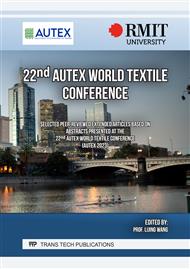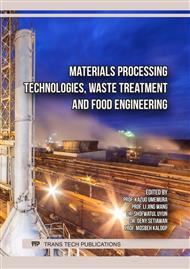[1]
Y. Swolfs, I. Verpoest, L. Gorbatikh. Recent advances in fibre-hybrid composites: materials selection, opportunities and applications. International Materials Reviews 2018;64:181215.
DOI: 10.1080/09506608.2018.1467365
Google Scholar
[2]
Ucan H, Scheller J, Nguyen C, Nieberl D, Beumler T, Haschenburger A. Automated, Quality Assured and High Volume Oriented Production of Fiber Metal Laminates (FML) for the Next Generation of Passenger Aircraft Fuselage Shells. Science and Engineering of Composite Materials 2019;26:502–8.
DOI: 10.1515/secm-2019-0031
Google Scholar
[3]
Khatri B, Rehra J, Schmeer S, Breuer U, Balle F. Metal/Carbon-Fiber Hybrid Composites—Damage Evolution and Monitoring of Isothermal Fatigue at Low and Elevated Temperatures. J Compos Sci 2022;6:67.
DOI: 10.3390/jcs6030067
Google Scholar
[4]
Alderliesten RC. Fatigue crack propagation and delamination growth in glare. Delft: Delft Univ. Press; 2005.
Google Scholar
[5]
Alderliesten R. Fatigue and fracture of fibre metal laminates. vol. v.236. Cham: Springer International Publishing; 2017.
Google Scholar
[6]
Khan SU, Alderliesten RC, Benedictus R. Delamination in Fiber Metal Laminates (GLARE) during fatigue crack growth under variable amplitude loading. International Journal of Fatigue 2011;33:1292–303.
DOI: 10.1016/j.ijfatigue.2011.04.002
Google Scholar
[7]
Backe S, Balle F, Hannemann B, Schmeer S, Breuer UP. Fatigue properties of multifunctional metal- and carbon-fibre-reinforced polymers and intrinsic capabilities for damage monitoring. Fatigue Fract Eng Mater Struct 2019;42:143–51.
DOI: 10.1111/ffe.12878
Google Scholar
[8]
Swolfs Y, McMeeking RM, Verpoest I, Gorbatikh L. The effect of fibre dispersion on initial failure strain and cluster development in unidirectional carbon/glass hybrid composites. Composites Part A: Applied Science and Manufacturing 2015;69:279–87. https://doi.org/10.1016/j.compositesa. 2014.12.001.
DOI: 10.1016/j.compositesa.2014.12.001
Google Scholar
[9]
Y. Swolfs, I. Verpoest, L. Gorbatikh. Maximising the hybrid effect in unidirectional hybrid composites. Materials & Design 2016;93:3945.
DOI: 10.1016/j.matdes.2015.12.137
Google Scholar
[10]
Maros Tunak, Veronika Tunakova, Martin Schindler, Jirazka. Spatial arrangement of stainless steel fibers within hybrid yarns designed for electromagnetic shielding. Textile Research Journal 2018;89:20192030.
DOI: 10.1177/0040517518783354
Google Scholar
[11]
Zheng S, Zou Z, Shen W, Cheng L. A study of the fiber distribution in yarn cross section for vortex-spun yarn. Textile Research Journal 2012;82:1579–86.
DOI: 10.1177/0040517511431315
Google Scholar
[12]
Baddeley A, Rubak E, Turner R. Spatial point patterns: Methodology and applications with R. Boca Raton: CRC Press Taylor & Francis Group; 2016.
DOI: 10.1111/biom.12533
Google Scholar
[13]
Wiegand T, Moloney KA. Handbook of Spatial Point-Pattern Analysis in Ecology. Chapman and Hall/CRC; 2013.
DOI: 10.1201/b16195
Google Scholar
[14]
Vihrs N. Using neural networks to estimate parameters in spatial point process models 2022.
DOI: 10.1016/j.spasta.2022.100668
Google Scholar
[15]
Xun Z, Ding X, Zhang Y, Zhang B, Lai S, Zou D, et al. Reconstruction of the tumor spatial microenvironment along the malignant-boundary-nonmalignant axis. Nat Commun 2023;14:933.
DOI: 10.1038/s41467-023-36560-7
Google Scholar
[16]
Parra ER. Methods to Determine and Analyze the Cellular Spatial Distribution Extracted From Multiplex Immunofluorescence Data to Understand the Tumor Microenvironment. Frontiers in Molecular Biosciences 2021;8.
DOI: 10.3389/fmolb.2021.668340
Google Scholar
[17]
Peng D, Gui Z, Wang D, Ma Y, Huang Z, Zhou Y, et al. Clustering by measuring local direction centrality for data with heterogeneous density and weak connectivity. Nat Commun 2022;13:5455.
DOI: 10.1038/s41467-022-33136-9
Google Scholar
[18]
Baddeley A, Turner R. spatstat : An R Package for Analyzing Spatial Point Patterns. Journal of Statistical Software 2005;. http://www.jstatsoft.org/v12/i06/.
DOI: 10.18637/jss.v012.i06
Google Scholar



